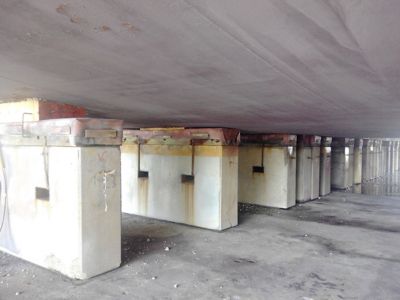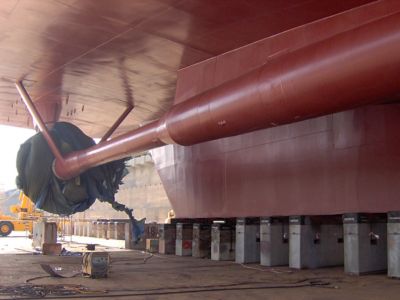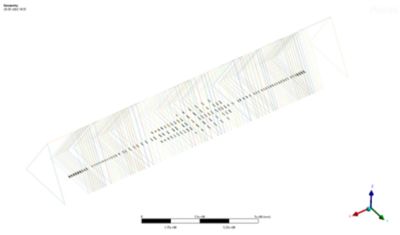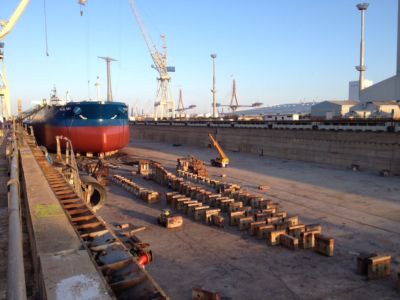-
United States -
United Kingdom -
India -
France -
Deutschland -
Italia -
日本 -
대한민국 -
中国 -
台灣
-
Ansys는 학생들에게 시뮬레이션 엔지니어링 소프트웨어를 무료로 제공함으로써 오늘날의 학생들의 성장을 지속적으로 지원하고 있습니다.
-
Ansys는 학생들에게 시뮬레이션 엔지니어링 소프트웨어를 무료로 제공함으로써 오늘날의 학생들의 성장을 지속적으로 지원하고 있습니다.
-
Ansys는 학생들에게 시뮬레이션 엔지니어링 소프트웨어를 무료로 제공함으로써 오늘날의 학생들의 성장을 지속적으로 지원하고 있습니다.
ANSYS BLOG
June 21, 2022
Simulation Ensures Dry Docks at Navantia with Easy-to-Use Automation Tool
Most of us think of a ship out at sea, floating freely on the open waters. Generally, we don’t consider where the ship receives maintenance or repair, or how it’s supported when it does. But mechanical engineers, architects, and designers carefully plan, construct, and configure ship docking supports for these purposes and more.
Dry docks are essentially narrow basins that can be flooded and drained intermittently to allow a ship to float in, get positioned onto these supports, and tended to above water level. As you can imagine, supports play an integral role in ship docking, so maintaining their stability is a top priority.
While dry dock crews are well-versed in such construction, technical input through simulation and automation are typically deemed unchartered waters. However, naval shipbuilder Navantia is venturing into new territory to advance traditional methods and introduce simulation use at their drydocking facility in southern Spain by using the Ansys Application Customization Tool Kit (ACT). Created in collaboration with Ansys engineers, Navantia uses a customized application, which they internally refer to as BEDCAL for bed calculations, to simplify and automate Ansys Mechanical structural finite element analysis (FEA) simulation from start to finish. The ACT application is designed to be simple, direct, and fuss-free for any user from novice to expert, democratizing simulation for the whole team.
By using BEDCAL, Navantia’s dry dock team simulates and optimizes the configuration of their docking supports with faster, more accurate calculations that slash preparation time in half and enable more speed and agility to meet changing business demands.
A Class ACT in Automation
There are no cliques here. Ansys ACT software welcomes everyone to the table regardless of their experience level with simulation. ACT enables you to automate workflows by creating customized guided processes referred to as wizards, which enable a step-by-step, accessible interface for any user.
The project department at Navantia is using a tailored wizard, appropriately named the Block Reaction Application, to calculate the reaction forces of supports — mainly keel or bilge blocks — at their docking facility near the Bay of Cádiz.

Figure 1. Model illustrates docking supports positioned under a ship.
Although Navantia’s fleet mainly consists of high-technology naval ships, it extends to other vessels in both military and civilian sectors — from submarines to cruise ships. With significantly diverse ship sizes and docking plans, every support requires a unique configuration ahead of each use, which results in a repetitive, meticulous, and time-consuming process. On average, a small vessel requires up to 100 supports while a larger ship may need up to 350 supports.
“The user-friendliness and flexibility of access and use of the Block Reaction Application is remarkable,” says Juana Fernández Sánchez, a project coordinator in the engineering department at Navantia. “The whole engineer group involved in these calculations has agreed with the tool and considers it to be very useful and easy to use.”

Figure 2. Large ships at Navantia generally require up to 350 docking supports.
Further, because the customization is built on Ansys Mechanical, the application enhances collaboration and provides a more seamless workflow between the project team and other departments using Mechanical, such as the structural analysis team.
Automation not only enables teams to calculate configurations easily, but also much faster, which accelerates operations and improves performance.
“The new BEDCAL Application has been a significant advancement in the calculation of reactions during floating, launching, and docking maneuvers,” says Sánchez. “It has been observed that the preparation and calculation time has been reduced around 50% in relation to the previous tool. It is also important to note the accuracy achieved in the new calculations through the use of finite elements through Ansys’ simulation.”

Figure 3. Closeup of docking supports at Navantia, mainly consisting of keel and bilge blocks.
Error-Free and 1, 2, 3? Yes, Please!
Accuracy is essential in the configuration of supports as stability is key during docking from start to finish. The loading conditions during docking and maneuver are often modified, which requires agility to constantly reassess the support conditions. Reaction forces must be analyzed and calculated for each support to determine structural safety before installation. This also maintains optimal equilibrium throughout the ship’s docking stay. Also, if one support is removed, slightly shifted, or arranged inaccurately, every calculation must be repeated and updated to ensure that the ship’s weight is dispersed properly onto the supports to prevent structural damage to the ship at any point.

Figure 4. The project department at Navantia uses the Ansys Application Customization Tool Kit (ACT) to calculate the reaction forces of supports at their docking facility near the Bay of Cádiz in Spain.
Maintaining such a large volume of data that fluctuates and demands razor-sharp precision requires cautious calculation and a lot of repetition. Unfortunately, this creates a vulnerability for error, which increases the risk of malfunction. But Navantia alleviates these concerns with the BEDCAL Application, while also freeing up the team to concentrate on other tasks.
“The data flow has been automated, which has had a double advantage: on one hand, human errors are reduced during data processing, and on the other hand, the required calculation time has been considerably reduced, thus providing greater agility in the decision-making process,” says Sánchez. “In addition, the Ansys ACT tool has optimized the calculation in such a way that once our model is set up, it is much easier and quicker to perform additional calculations or to modify some of the characteristics of the supports that make up the bed.”
Coupled with burdensome calculations, another common pain point in support configuration involves data storage. Navantia implements the application for this purpose as well, applying the tool for more secure and efficient record keeping.
With new digitalized calculations, the team easily maintains an electronic database for future projects, while also applying the automation tool during file input and output within Microsoft Excel.
After a successful integration of the tool for block configuration, Navantia is leveraging ACT in a number of different workflows, automating tedious and manual processes to reduce simulation time and streamline complex analyses.

Figure 5. Mechanical teams at Navantia prepare geometry and model ship hull and support blocks in Ansys Mechanical.
Other departments throughout Navantia, particularly the mechanical systems team, already integrate Ansys’ simulation and tools, including Ansys Mechanical for the assessment of hull behavior and overall resistance; Ansys Fluent for HVAC system, piping, and flow analysis; Ansys LS-Dyna for explosions and ballistics; and Ansys HFSS for antenna placement and radar cross section.
With a history dating back to Spain’s first modern shipyard in 1717, coupled with the ability to embrace today’s latest simulation technology, Navantia certainly knows the ropes. For more information, visit Navantia.

Figure 6. A dry dock at Navantia in southern Spain.










